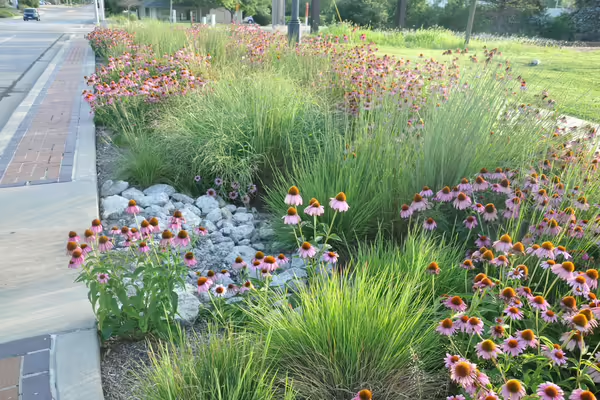
URBANA, Ill. – During large rainstorms, many Illinois residents brace themselves for flooding in their basements, streets, and neighborhoods. Illinois Groundwork, illinoisgroundwork.org, is a new free, online tool for communities and stormwater professionals with resources on green stormwater infrastructure, which provides a way for rain to be absorbed into the soil where it lands.
Green stormwater infrastructure is an approach to enhancing traditional or “grey” infrastructure using a rain garden or even permeable pavement. But this method doesn’t always work as well as it might. By improving access to data, research, and other resources, this tool can help increase the effective use of green infrastructure to address stormwater management challenges.
“University of Illinois not only has relevant research and data across many departments but also real-world examples of successful green infrastructure, along with other University of Illinois Extension and education tools, such as the Red Oak Rain Garden,” says C. Eliana Brown, Illinois Extension stormwater specialist. “This new tool brings these resources together, providing a robust platform to access green infrastructure knowledge.”
The project is a collaboration between Illinois-Indiana Sea Grant and Illinois Extension. A critical component of Illinois Groundwork is an IISG-funded research project that focused on including soil data in green infrastructure design. Soils are the foundation of effective green stormwater infrastructure performance.
“Soil characteristics establish how much and how fast water can move through and absorb into the soil,” says Margaret Schneemann, IISG water resource economist. “Failing to take soil performance into account means we are not designing green infrastructure as cost effectively as we could be and may be leaving its benefits on the table.”
The goal of Illinois Groundwork is to complement and deepen existing community knowledge with better design capacity and soil knowledge to support local decision-making, says Mary Pat McGuire, University of Illinois landscape architect, who led the soil research. “Ultimately, design is a social process, people coming together to make a change,” McGuire says.
The web tool outlines a process that users can follow to incorporate soil data into green infrastructure design. Illinois Groundwork provides insights into helpful or necessary expertise, specific tasks, and additional resources. It also includes an interactive resource to help optimize green infrastructure sizing and Plant Finder, which covers 119 plants, with information on soil type, light, and moisture needs for each, as well as photos and descriptions.
“Plant Finder helps designers select plants that are best suited for site conditions and promotes designing with maintenance in mind,” says Layne Knoche, University of Illinois stormwater associate. Other resources include relevant Illinois regulations, scientific literature addressing a range of green infrastructure benefits, and real-world green infrastructure examples.
Illinois Groundwork was made possible through a University of Illinois Urbana-Champaign and Illinois Extension collaboration grant. For more information or questions about the website, contact the IISG team at iisg@purdue.edu or (765) 496-6009. Stormwater quality is regulated at the federal level via the Clean Water Act contains an amendment (33 USC 1342) creating the National Pollutant Discharge Elimination System Storm Water Management Program, which the U.S. EPA oversees.
Source: Margaret Schneemann, Illinois-Indiana Sea Grant, resource economist; Mary Pat McGuire, University of Illinois Urbana-Champaign, associate professor, and licensed landscape architect; C. Eliana Brown, Illinois Extension stormwater specialist; Layne Knoche, University of Illinois stormwater associate.
About Illinois-Indiana Sea Grant: One of 34 Sea Grant Programs in the US, IISG is focused on the southern Lake Michigan region. The program is funded through National Oceanic and Atmospheric Administration (NOAA), the University of Illinois, and Purdue University, but IISG also works in partnerships with scientists, educators, policymakers, business leaders, and the public to work towards a healthy environment and economy.
Illinois Extension leads public outreach for University of Illinois by translating research into action plans that allow Illinois families, businesses, and community leaders to solve problems, make informed decisions, and adapt to changes and opportunities. Illinois Extension is part of the University of Illinois Urbana-Champaign College of Agricultural, Consumer and Environmental Sciences.